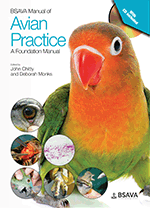
Full text loading...

Abnormal droppings, and a decreased appetite, are probably the most frequent first clinical signs of gastrointestinal tract disease. This chapter provides information on the normal appearance of droppings and a systematic approach to diagnosis of the underlying conditions causing diarrhoea. Case examples: African Grey Parrot with green, malodorous, voluminous faeces; Hawk-headed Parrot with haematochezia; Cockatiel with biliverdinuria.
Abnormal or loose droppings, Page 1 of 1
< Previous page | Next page > /docserver/preview/fulltext/10.22233/9781910443323/9781910443323.24-1.gif

Full text loading...












